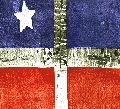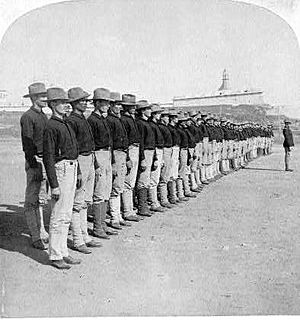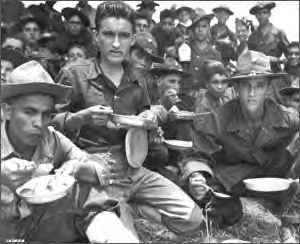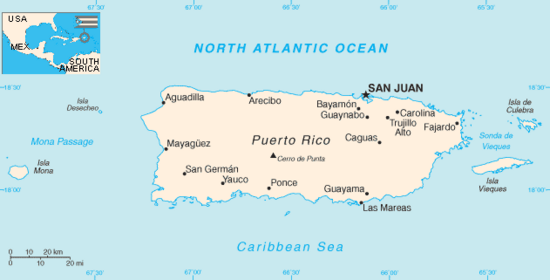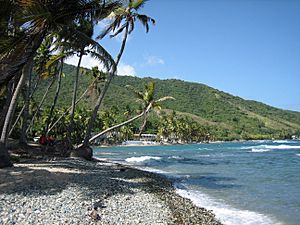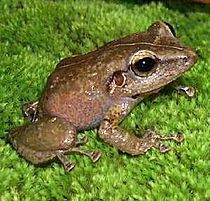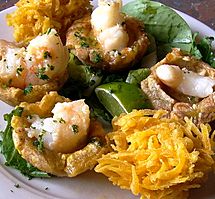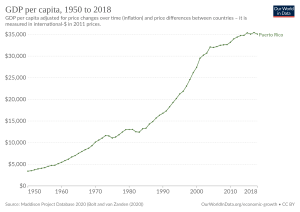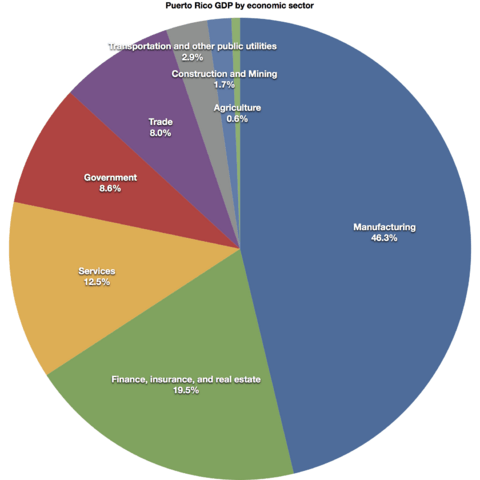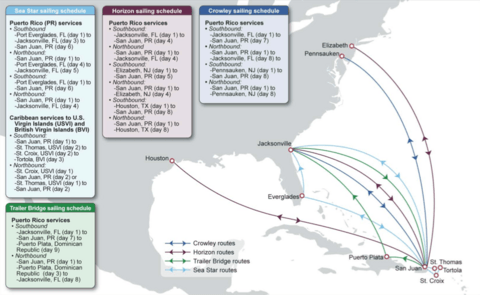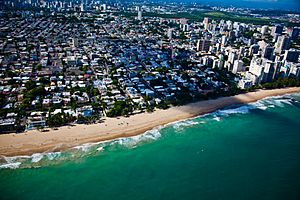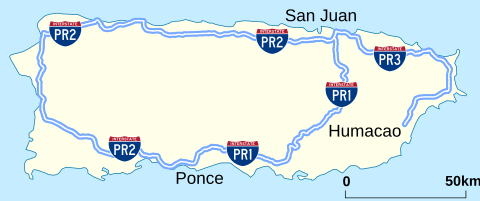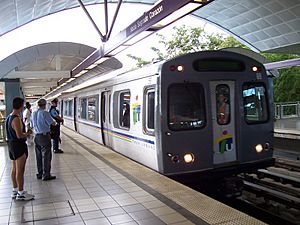Puerto Rico facts for kids
Quick facts for kids
Puerto Rico
|
|||||
|---|---|---|---|---|---|
| Commonwealth of Puerto Rico Free Associated State of Puerto Rico Estado Libre Asociado de Puerto Rico (Spanish) |
|||||
|
|||||
| Nickname(s): | |||||
| Motto(s): | |||||
| Anthem: "La Borinqueña" (Spanish) (English: "The Borinquenian") |
|||||
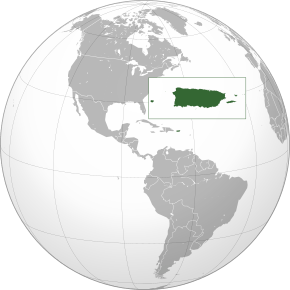
Location of Puerto Rico
|
|||||
| Sovereign state | United States | ||||
| Before annexation | Captaincy General of Puerto Rico | ||||
| Cession from Spain | 11 April 1899 | ||||
| Current constitution | 25 July 1952 | ||||
| Capital and largest city
|
San Juan 18°27′N 66°6′W / 18.450°N 66.100°W |
||||
| Common languages | 94.3% Spanish 5.5% English 0.2% other |
||||
| Official languages | |||||
| Ethnic groups
(2020)
|
By race:
By ethnicity:
|
||||
| Demonym(s) |
|
||||
| Government | Devolved presidential constitutional dependency | ||||
| Joe Biden (D) | |||||
|
• Governor
|
Pedro Pierluisi (PNP/D) | ||||
| Legislature | Legislative Assembly | ||||
| Senate | |||||
| House of Representatives | |||||
| Area | |||||
|
• Total
|
9,104 km2 (3,515 sq mi) | ||||
|
• Water (%)
|
1.6 | ||||
| Highest elevation | 4,390 ft (1,340 m) | ||||
| Population | |||||
|
• 2020 census
|
3,285,874 | ||||
|
• Density
|
350.8/km2 (908.6/sq mi) (39th) | ||||
| GDP (PPP) | 2021 estimate | ||||
|
• Total
|
$112.273 billion | ||||
|
• Per capita
|
$35,943 (40th) | ||||
| GDP (nominal) | 2021 estimate | ||||
|
• Total
|
$100.684 billion (61st) | ||||
|
• Per capita
|
$32,233 (28th) | ||||
| Gini (2011) | 53.1 high |
||||
| HDI (2015) | 0.845 very high · 40th |
||||
| Currency | United States dollar (US$) (USD) | ||||
| Time zone | UTC-04:00 (AST) | ||||
| Date format | mm/dd/yyyy | ||||
| Driving side | right | ||||
| Calling code | +1 (787), +1 (939) | ||||
| USPS abbreviation |
PR
|
||||
| ISO 3166 code |
|
||||
| Internet TLD | .pr | ||||
Puerto Rico (which means "rich port" in Spanish) is a beautiful Caribbean island. It is an unincorporated territory of the United States. You can find it in the northeast Caribbean Sea, about 1,000 miles (1,600 km) southeast of Miami, Florida.
Puerto Rico is an archipelago (a group of islands) in the Greater Antilles. It is located between the Dominican Republic and the United States Virgin Islands. The main island is Puerto Rico itself, but there are also smaller islands like Mona, Culebra, and Vieques. About 3.2 million people live there. Its capital and largest city is San Juan. Both Spanish and English are official languages, but most people speak Spanish.
People have lived in Puerto Rico for thousands of years. The Taíno people were living there when Christopher Columbus arrived in 1493. After that, Spain took control of the island. It remained a Spanish possession for about 400 years. During this time, many African people were brought to the island against their will to work. Also, settlers from Spain came to live there. This mix of people created the unique culture of Puerto Rico.
In 1898, after the Spanish–American War, the United States took control of Puerto Rico. Since 1917, people born in Puerto Rico have been U.S. citizens. This means they can travel freely between the island and the mainland United States. However, they cannot vote for the U.S. president or vice president. They also generally do not pay federal income tax. Puerto Rico sends a non-voting representative to the U.S. Congress. In 1952, Puerto Rico approved its own local constitution. This allowed the people to elect their own governor.
Since the mid-1900s, the U.S. government has helped Puerto Rico grow its economy. They focused on manufacturing (like medicines and electronics) and tourism. Today, Puerto Rico is considered a developed place with a high-income economy. It ranks high on the Human Development Index.
Contents
What's in a Name?
People from Puerto Rico often call their island Borinquen. This name comes from the native Taíno name Borikén. It means "Land of the Valiant Lord." The words boricua and borincano are used to describe someone with Puerto Rican heritage. Many also call the island la isla del encanto, which means "the island of enchantment."
When Christopher Columbus arrived in 1493, he named the island San Juan Bautista. This was in honor of Saint John the Baptist. The capital city was named Ciudad de Puerto Rico, meaning "Rich Port City." Over time, traders and sailors started calling the whole island "Puerto Rico." The name San Juan then became used for the main port and the capital city.
The United States changed the island's name to "Porto Rico" after the Treaty of Paris of 1898. This was the agreement that ended the Spanish-American War. The U.S. government used this English version of the name. But in 1931, the name was changed back to "Puerto Rico" by the U.S. Congress.
Puerto Rico's Past
Early History of the Island

The very old history of Puerto Rico is not fully known. Unlike other ancient cultures, the native people of Puerto Rico did not leave many artifacts. What we know comes from a few archaeological finds and early Spanish writings.
The first people to settle here were the Ortoiroid people. They were hunters and fishermen who came from South America. Some experts think they arrived as far back as 4,000 years ago. Later, the Saladoid people arrived, followed by the Igneri tribe.
Between the 7th and 11th centuries, the Taíno culture became strong on the island. When Columbus arrived, about 30,000 to 60,000 Taíno people lived there. Their chief was named Agüeybaná. They called their island Boriken. The Taíno lived in small villages led by a chief. They hunted, fished, and grew plants like cassava.
Spanish Rule (1493–1898)
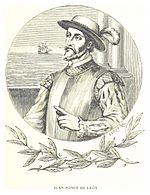
When Columbus arrived in Puerto Rico on November 19, 1493, the Taíno people were living there. Columbus named the island San Juan Bautista. In 1508, Juan Ponce de León, a Spanish explorer, started the first Spanish settlement called Caparra. He later became the island's first governor.
In the early 1500s, Spain began to colonize the island. Some Taíno people were forced into a system of forced labor. Many also died from European diseases. By 1520, the remaining Taíno people were freed. However, enslaved Africans were brought to the island to replace the lost labor.
Puerto Rico became an important military outpost for Spain. Its capital, San Juan, was heavily fortified. This was to protect Spanish claims and ensure safe passage for ships carrying treasure. The city was known as the "Walled City." You can still see many forts and walls today, like La Fortaleza, Castillo San Felipe del Morro, and Castillo San Cristóbal. These were built to defend against attacks from other European countries.
In 1625, the Dutch commander Boudewijn Hendricksz attacked San Juan. He sailed his 17 ships into the bay and attacked the city. The people took shelter behind the fort walls. The Dutch set the village on fire, but they could not capture the main fort, El Morro. This attack led to even more fortifications being built.
Later, in the 1700s, Spain started paying more attention to Puerto Rico. More roads were built, connecting inland towns to coastal cities. Trade with other nations also increased. More enslaved Africans were brought to work on sugar and coffee farms. In 1797, a British fleet tried to invade the island but was defeated by Spanish troops.
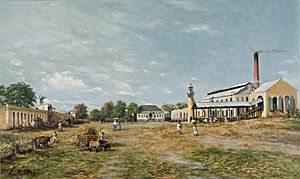
In 1809, Spain recognized Puerto Rico as an overseas province. This gave the islanders the right to elect representatives to the Spanish parliament. This was a big step for the island.
In the 19th century, some people in Puerto Rico wanted independence. They were inspired by leaders like Simón Bolívar. However, the Spanish authorities stopped these movements. To keep control, Spain encouraged more Europeans to move to Puerto Rico. They offered free land to those who promised loyalty to Spain and the Catholic Church. This led to many families from places like Canary Islands, Corsica, France, and Germany settling on the island.
Poverty and a desire for freedom led to a small uprising in 1868 called Grito de Lares. It was quickly stopped. Slavery was officially ended in Puerto Rico in 1873.
Another uprising, the Intentona de Yauco, happened in 1897. The rebels raised what they called the Puerto Rican flag. However, this revolt was also stopped by Spanish authorities. In the same year, Spain granted Puerto Rico limited self-government. This meant they had their own parliament, but a governor appointed by the King of Spain still held power.
American Rule (1898–Present)
In 1898, during the Spanish–American War, the United States invaded Puerto Rico. After the war, Spain gave Puerto Rico, along with the Philippines and Guam, to the U.S. under the Treaty of Paris.
In the early 1900s, the U.S. military governed Puerto Rico. The Foraker Act of 1900 gave Puerto Rico some civilian government. It allowed for an elected House of Representatives. However, the U.S. appointed the governor and the upper house. Puerto Rico also got a non-voting representative in Congress.
In 1917, the U.S. Congress passed the Jones–Shafroth Act, also known as the Jones Act. This law made Puerto Ricans U.S. citizens. Some people thought this was done to allow Puerto Rican men to join the U.S. army during World War I. The Act also created a popularly elected Senate and a bill of rights for the island.
Natural disasters and the Great Depression caused hardship in Puerto Rico. Some leaders, like Pedro Albizu Campos, wanted changes in the relationship with the U.S. In 1935, a protest at the University of Puerto Rico led to a tragic event where people were killed by police. Another protest in 1937 in Ponce also resulted in many deaths when police opened fire on unarmed people. This event is known as the Ponce massacre.
In 1946, President Truman appointed the first Puerto Rican-born governor, Jesús T. Piñero. In 1947, Puerto Ricans gained the right to elect their own governor. In 1948, Luis Muñoz Marín became the first popularly elected governor.
A law called the Gag Law was passed in 1948. It made it illegal to display a Puerto Rican flag or speak about independence. This law was very strict and limited freedom of speech. It was later removed in 1957.
In 1950, the U.S. Congress allowed Puerto Rico to draft its own local constitution. This constitution was approved in 1952. Puerto Rico adopted the name Estado Libre Asociado de Puerto Rico, which is officially translated as Commonwealth. Even with its own constitution, the U.S. Congress still makes laws about many important parts of life in Puerto Rico.

During the 1950s and 1960s, Puerto Rico grew quickly in industry. This was due to a plan called Operación Manos a la Obra ("Operation Bootstrap"). This plan aimed to change Puerto Rico's economy from farming to manufacturing. Today, Puerto Rico is a popular tourist spot and a major center for making medicines.
Voting on the Island's Future
Since the late 1900s, Puerto Rico has held votes, called plebiscites, to decide its political status. In these votes, people choose if they want Puerto Rico to become a U.S. state, be fully independent, or have a special "free association" with the U.S.
The most recent vote in 2012 showed that most voters wanted a change in status, with statehood being the most popular choice among those who wanted a change. However, many blank ballots were cast, which caused confusion. Because of this, the U.S. Congress decided not to act on the results.
The Puerto Rican status referendum, 2017 offered two choices: statehood or independence/free association. If people chose the second option, another vote would decide between full independence or a free association. This free association could be similar to how the U.S. relates to countries like Micronesia or Palau. These countries use the U.S. dollar and get some financial and military support from the U.S. Their citizens can also work in the U.S. and serve in its military.
Many leaders, like Governor Pedro Pierluisi, support statehood. They believe it would help the economy and give Puerto Ricans more rights. Benefits of statehood could include more federal money and the right to vote in presidential elections. It might also help with the island's financial problems. However, any change to Puerto Rico's status needs approval from the United States Congress.
The UN has also been discussing Puerto Rico's status since 1953. The Special Committee on Decolonization has said that Puerto Rico has a "colonial relationship" with the U.S. They often call Puerto Rico a "nation" because of its unique identity. In 2016, the Special Committee asked the U.S. to help Puerto Rico achieve self-determination and address its economic and social needs.
Island Geography
Puerto Rico includes the main island and several smaller ones. These include Vieques, Culebra, Mona, Desecheo, and Caja de Muertos. Only Culebra and Vieques have people living on them all year. Culebra is famous for Flamenco Beach, which some say is one of the best beaches in the world.
The Commonwealth of Puerto Rico covers about 5,324 square miles (13,790 square kilometers). The main island is about 112 miles (180 km) long from east to west and 40 miles (65 km) wide from north to south. Puerto Rico is the smallest of the Greater Antilles islands.
The island is mostly mountainous. It has large flat areas along the north and south coasts. The main mountain range is called "La Cordillera Central" (The Central Range). The highest point in Puerto Rico, Cerro de Punta, is in this range. It is 4,390 feet (1,340 meters) high. Another important peak is El Yunque, located in the El Yunque National Forest.
Puerto Rico has 17 man-made lakes and over 50 rivers. Most rivers start in the Central Range. Rivers in the north are usually longer and have more water than those in the south. This is because the north gets more rain.
Puerto Rico is located where the Caribbean and North American tectonic plates meet. The movement of these plates can cause earthquakes and tsunamis. The last major earthquake happened in 1918. It caused a lot of damage and led to about 116 deaths.
The Puerto Rico Trench is the deepest part of the Atlantic Ocean. It is about 70 miles (115 km) north of Puerto Rico. This trench is 174 miles (280 km) long and almost 27,560 feet (8,400 meters) deep at its lowest point, called the Milwaukee Deep.
Island Climate
Puerto Rico is in the tropics, so it has a rainy season from April to November. The mountains cause different temperatures and rainfall in different areas. The average temperature is about 82.4°F (28°C) all year. Temperatures do not change much between seasons. The south is usually a bit warmer than the north. The mountains are always cooler.
Puerto Rico experiences the Atlantic hurricane season. On average, a tropical storm passes near the island every five years. A hurricane passes by every seven years. Only one very strong hurricane (Category 5) has hit the island since 1851. This was the Lake Okeechobee Hurricane in September 1928.
Amazing Animals and Plants
Puerto Rico is home to many unique plants and animals. There are 239 plant species, 16 bird species, and 39 amphibian/reptile species that are found only on the island. The most famous animal and a symbol of Puerto Rican pride is the coquí. This is a small frog known for its loud call, which sounds like "co-qui." Most coquí species live in the El Yunque National Forest. This is a tropical rainforest in the northeast. El Yunque has over 240 plant species, and 26 of them are found only there. It is also home to 50 bird species, including the very rare Puerto Rican amazon parrot.
In the southwest, the Guánica Commonwealth Forest Reserve is a dry area with over 600 rare plant and animal species. This includes 48 endangered species and 16 species found only in Puerto Rico.
People of Puerto Rico
| Historical population | |||
|---|---|---|---|
| Census | Pop. | %± | |
| 1800 | 155,426 | — | |
| 1860 | 583,308 | — | |
| 1910 | 1,118,012 | — | |
| 1920 | 1,299,809 | 16.3% | |
| 1930 | 1,543,913 | 18.8% | |
| 1940 | 1,869,255 | 21.1% | |
| 1950 | 2,210,703 | 18.3% | |
| 1960 | 2,349,544 | 6.3% | |
| 1970 | 2,712,033 | 15.4% | |
| 1980 | 3,196,520 | 17.9% | |
| 1990 | 3,522,037 | 10.2% | |
| 2000 | 3,808,610 | 8.1% | |
| 2010 | 3,725,789 | −2.2% | |
| 2020 | 3,285,874 | −11.8% | |
| 1765–2020 | |||
The population of Puerto Rico has been shaped by its first native people, European settlers, slavery, and people moving for jobs.
Who Lives in Puerto Rico?
| Racial and Ethnic Composition in Puerto Rico (2020 Census) | ||||
|---|---|---|---|---|
| Ethnicity | ||||
| White | 17.1% | |||
| Black | 7.0% | |||
| Asian | 0.1% | |||
| Two or more races | 49.8% | |||
| American Indian | 0.5% | |||
| Native Hawaiian and Other Pacific Islander | 0.0% | |||
| Other races | 25.5% | |||
In 2020, Puerto Rico had 3,285,874 people. This was a decrease from 2010. The population grew a lot from 1800 to the late 1800s due to European immigration and more births.
During the 19th century, many families came to Puerto Rico. Most were from Spain, especially the Canary Islands and Andalusia. Others came from places like Corsica, France, Germany, and Ireland. This was because of a law called the Real Cedula de Gracias de 1815. It allowed European Catholics to settle on the island and get land.
In the 2000 U.S. Census, most Puerto Ricans identified as white and Latino. Few identified as Black or other races. Studies of DNA show that modern Puerto Ricans have a mix of Taíno (native), European (mostly Spanish), and African ancestry.
Moving In and Out
| Racial groups | ||||||
| Year | Population | White | Mixed (mainly biracial white European and black African) | Black | Asian | Other |
|---|---|---|---|---|---|---|
| 2000 | 3,808,610 | 80.5% (3,064,862) | 11.0% (418,426) | 8.0% (302,933) | 0.2% (7,960) | 0.4% (14,429) |
| 2010 | 3,725,789 | 75.8% (2,824,148) | 11.1% (413,563) | 12.4% (461,998) | 0.2% (7,452) | 0.6% (22,355) |
| 2016 | 3,195,153 | 68.9% (2,201,460) | n/a (n/a) | 9.8% (313,125) | 0.2% (6,390) | 0.8% (25,561) |
Puerto Rico has about 100,000 legal residents who live there permanently. Most recent immigrants come from the Dominican Republic and Haiti. Many U.S. citizens from the mainland also move to Puerto Rico.
Many Puerto Ricans have moved to the United States mainland, especially after World War II. This was due to poverty and cheap flights. This trend continues today, even as Puerto Rico's economy has improved. In recent years, the population has decreased a lot. This is because fewer babies are being born and more people are moving away. The hurricanes Maria and Irma in 2017 also caused many people to leave.
More Puerto Ricans now live in the United States outside of Puerto Rico than on the island itself. People who leave are often more educated, which affects Puerto Rico's economy.
Where People Live
The largest city is the capital, San Juan. It has about 318,441 people. Other big cities include Bayamón, Carolina, Ponce, and Caguas. Most of the largest cities are in the San Juan metropolitan area.
|
Largest cities or towns in Puerto Rico
2010 Census |
||
|---|---|---|
| Rank | Name | Pop. |
| 1 | San Juan | 395,326 |
| 2 | Bayamón | 208,116 |
| 3 | Carolina | 176,762 |
| 4 | Ponce | 166,327 |
| 5 | Caguas | 142,893 |
| 6 | Guaynabo | 97,924 |
| 7 | Arecibo | 96,440 |
| 8 | Toa Baja | 89,609 |
| 9 | Mayagüez | 89,080 |
| 10 | Trujillo Alto | 74,842 |
Languages Spoken
The official languages of Puerto Rico's government are Spanish and English. Spanish is the main language. Almost all public school instruction is in Spanish. English is taught as a second language from elementary school to high school.
About 94.3% of people aged five and older speak only Spanish at home. Only 5.5% speak English. Puerto Rican Spanish has its own unique words and ways of speaking. It includes words from the Taíno people and from African languages. The biggest influence on Puerto Rican Spanish comes from the Canary Islands in Spain.
Religion on the Island
Religious affiliation in Puerto Rico (2014) Roman Catholicism (56%) Protestantism (33%) Other (3%) Irreligious (8%)
Catholicism was brought by Spanish colonists and became the main religion. The first Catholic dioceses in the Americas were set up in Puerto Rico in 1511. All towns in Puerto Rico have at least one Catholic church, usually in the town center.
Protestantism grew after the United States took control. This made Puerto Rico more diverse in its religions. The first Protestant church was built in Ponce in 1872. It was the first non-Catholic church in the Spanish Empire in the Americas.
A 2014 survey showed that 56% of Puerto Ricans were Catholic. About 33% were Protestant, and 8% did not identify with a religion. There are also smaller communities of Eastern Orthodox, Baháʼí, Jehovah's Witnesses, and Buddhists. There is a Jewish community, the largest in the Caribbean. There are also about 5,000 Muslims on the island.
Puerto Rican Culture
Puerto Rican culture is a special blend of different influences. It includes elements from the Taíno people, European (mostly Spanish), African, and more recently, North American cultures.
From Spain, Puerto Rico got the Spanish language, the Catholic religion, and many cultural values. The United States brought English language influence, the university system, and some holidays. The University of Puerto Rico was founded in 1903.
Music is a very important part of Puerto Rican culture. It has been shaped by Spanish and African traditions, mixed with local rhythms. Later, music from other Caribbean islands and North America also influenced it.
The official symbols of Puerto Rico are the Puerto Rican spindalis (a bird), the flor de maga (a flower), and the kapok (a tree). The unofficial animal and a symbol of Puerto Rican pride is the coquí frog.
Buildings and Art
The buildings in Puerto Rico show many different styles from over 400 years of Spanish rule and 100 years of American rule. You can see Spanish colonial, art deco, and other styles.
Old San Juan is a historic part of the capital city. It has many shops, museums, cafes, and beautiful old homes. It is a popular place for tourists. The district has many public plazas and churches, like San José Church and the Cathedral of San Juan Bautista. The oldest parts of Old San Juan are still surrounded by large walls. Forts like Fort San Felipe del Morro and Castillo San Cristóbal protected the city from attacks. La Fortaleza is another important building that serves as the governor's home.
In the 1940s, parts of Old San Juan were falling apart. But strict rules were put in place to keep the old Spanish colonial style. This helped save the historic buildings and inspired other cities to do the same.
Ponce Creole is a unique architectural style found in Ponce, Puerto Rico. It mixes French, Spanish, and Caribbean traditions. These houses were built to handle the hot, dry climate. They used wood and stone and included elements from other styles like Classical revival and Victorian.
Puerto Rican art shows many influences from its diverse background. One type of folk art is called santos. These are sculptures of saints and religious figures made from wood, clay, or stone. They are often painted in bright colors. Santos were seen as messengers between earth and heaven.
Another popular art form is caretas or vejigantes. These are masks worn during carnivals. They often have horns and fangs. They were traditionally red and black, but now come in many bright colors. They are usually made from papier-mâché.
Stories and Songs
Puerto Rican literature started with oral storytelling. For a long time, the Spanish government did not allow native islanders to write books. Only those approved by the Spanish Crown could write. Diego de Torres Vargas wrote the first detailed history of the island in 1647.
In the late 1800s, with the first printing press, Puerto Rican literature began to grow. Writers started to express their political views. After the U.S. took control, writers wrote about patriotic themes.
Alejandro Tapia y Rivera is known as the Father of Puerto Rican Literature. Many other writers have become famous, both on the island and around the world. These include Luis Rafael Sánchez and Esmeralda Santiago.
The music of Puerto Rico is a mix of different cultures. The main influences are from Spain and West Africa. But music from other parts of Europe and the Caribbean, and from the U.S., has also played a big role. Puerto Rican music has many styles, from traditional bomba and plena to modern reggaeton.
In classical music, Puerto Rico has two main orchestras. The Casals Festival in San Juan brings classical musicians from all over the world. Famous Puerto Rican singers include the opera tenor Antonio Paoli. Many Puerto Rican artists, like Jose Feliciano and Ricky Martin, are known worldwide.
Delicious Food
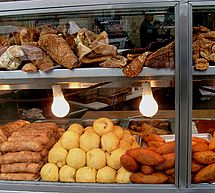
Puerto Rican food, called cocina criolla, mixes cooking traditions from Europe (Spain), Africa, and the native Taíno people. In the late 1800s, U.S. food also influenced it. Puerto Rican dishes are now found in many countries.
Basic ingredients include grains, beans, herbs, spices, root vegetables, meats, seafood, and fruits. Popular dishes are mofongo, arroz con gandules (rice with pigeon peas), pasteles, and pig roast (lechón). Drinks include piña colada. Desserts include arroz con dulce (sweet rice pudding) and tembleque.
From the Taíno people, Puerto Rican cuisine got many tropical roots like yautía (taro) and Yuca (cassava). They also used peppers, peanuts, guavas, and pineapples.
Spanish and European influences brought wheat, chickpeas, olive oil, onions, garlic, oregano, chicken, beef, pork, and cheese. The way complex stews and rice dishes are cooked also comes from Europe.
From Africa, Puerto Rico got coconuts, coffee, okra, yams, and pigeon peas. All these different traditions came together to create the unique La Cocina Criolla.
Sports and Stamps
Baseball is very popular in Puerto Rico. The Puerto Rico Baseball League is the island's professional league. Famous Puerto Rican baseball players include Roberto Clemente and Roberto Alomar.
Boxing, basketball, and volleyball are also popular. Puerto Rico has produced many boxing world champions. The Puerto Rico national basketball team has won many medals in international games. In 2004, they famously beat the U.S. team in the Olympics.
Puerto Rico has teams in all major international competitions, including the Summer and Winter Olympics. Puerto Rican athletes have won nine Olympic medals. Mónica Puig won the first gold medal for Puerto Rico in tennis at the 2016 Rio Olympics.
Puerto Rico has been honored on four U.S. postal stamps. Four Puerto Rican people have also been featured on U.S. stamps. These include baseball legend Roberto Clemente and the first elected governor, Luis Muñoz Marín.
Island Economy
Puerto Rico has a high-income economy. It is considered the most competitive economy in Latin America. Its economy is mainly driven by manufacturing, especially medicines, and by services like finance and tourism. Farming makes up a very small part of the economy.
Puerto Rico's economy faces challenges because it is a small island. It does not have many natural resources, so it depends on imports. It is also affected by U.S. policies and trade rules.
Puerto Rico had an economic downturn from 2006 to 2011. It went into another downturn in 2013. This was partly due to financial problems and the end of certain tax benefits for U.S. companies. Puerto Rico has managed to keep prices relatively stable. Its buying power per person is higher than in 80% of the world.
Many experts believe Puerto Rico's economic problems come from old federal rules. Also, the island has struggled to become self-sufficient. Its local government has also built up a large public debt. Puerto Rico's debt is about $72.2 billion.
Compared to U.S. states, Puerto Rico is poorer than Mississippi, the poorest U.S. state. About 41% of its people live below the poverty line. However, it has the highest GDP per person in Latin America. Puerto Rico's main trading partners are the United States, Ireland, and Japan. Most products come from East Asia.
Tourism in Puerto Rico
Tourism in Puerto Rico is a very important part of the economy. In 2017, Hurricane Maria caused a lot of damage to the island. This stopped tourism for many months. By April 2019, most hotels were open again. Life for tourists in San Juan had mostly returned to normal. By October 2019, nearly all tourist spots were open. Tourism was starting to recover. This is important because tourism provides up to 10% of Puerto Rico's economy.
In late 2019, some cruise ship visits to San Juan were canceled for 2020 and 2021. This meant fewer visitors and a loss of money for the island. The reason was that the cruise docks needed a lot of repairs and upgrades.
Financial Challenges
In early 2017, Puerto Rico faced a serious financial crisis. The government had a huge debt of $70 billion. The island had been in a recession for a decade.
Puerto Rico had been unable to pay many of its debts since 2015. The governor faced the risk of the government shutting down. An oversight board was created to help manage Puerto Rico's finances. This board asked the governor to create a plan to solve the debt problems. It is very important for Puerto Rico to reach agreements with its creditors to avoid a type of bankruptcy.
In August 2017, the oversight board planned to make government employees take two days off without pay each month. This was to save money. The governor did not agree with this plan. They also discussed reducing pension benefits to help with the $50 billion in unpaid pensions.
Government Spending
Puerto Rico's government budget is about $9.8 billion, but its expenses are about $10.4 billion. This creates a deficit of $775 million. For many years, the government has approved budgets with this kind of deficit. They often issued bonds (borrowed money) to cover these deficits. This has increased Puerto Rico's total debt.
About 9.6% of Puerto Rico's central government budget is spent on paying back debt. Even bigger budget cuts are expected in the future.
The budget is divided into a "general budget" and a "consolidated budget." The consolidated budget is usually three times larger. It includes money from federal U.S. subsidies and government-owned companies.
Government-owned companies add a lot to the debt. For example, in 2011, the electric power company and the water company lost a lot of money. These losses were covered by borrowing more money. This has made up more than 40% of Puerto Rico's public debt today.
The governor creates the budget and sends it to the legislature for approval. Once approved, the Department of Treasury manages the funds.
Cost of Living
The cost of living in Puerto Rico is high and has increased. This is partly due to the high cost of electricity, which is much higher than the U.S. average. Travel costs are also higher, and there are extra shipping fees.
The average household income in Puerto Rico is $19,350. About 45.5% of people live below the poverty line.
One big reason for the high cost of living is the Merchant Marine Act of 1920, also known as the Jones Act. This law says that only U.S.-flagged ships can carry goods between two American ports. This means foreign ships cannot drop off goods in Puerto Rico and then pick up goods made in Puerto Rico to take to the U.S. mainland. Instead, goods must go to U.S. ports first, then be sent to Puerto Rico on U.S. ships. This adds to shipping costs.
The government of Puerto Rico has asked the U.S. Congress many times to remove Puerto Rico from the Jones Act. They believe it would lower costs. A 2013 report found that changing the Jones Act might reduce shipping costs. However, a 2018 study said the Jones Act does not affect retail prices or the cost of living in Puerto Rico. It found that shipping rates to Puerto Rico were similar to or lower than those to other islands.
Education on the Island
The first school in Puerto Rico was the Escuela de Gramática (Grammar School). It was started in 1513 by Bishop Alonso Manso. The school was free and taught subjects like Latin, literature, history, and philosophy.
Education in Puerto Rico has three levels: Primary (grades 1–6), Secondary (grades 7–12), and Higher Level (college and graduate studies). In 2002, about 94.1% of Puerto Ricans could read and write. By 2000, 60% of the population had a high school degree or higher.
School is required for children between the ages of 5 and 18. As of 2010, there were 1,539 public schools and 806 private schools.
The largest university system is the public University of Puerto Rico (UPR), which has 11 campuses. There are also large private university systems like the Sistema Universitario Ana G. Mendez. Other private universities include the Inter American University and the Pontifical Catholic University. Puerto Rico has four medical schools and three law schools.
Island Infrastructure
Getting Around Puerto Rico
Cities and towns in Puerto Rico are connected by a system of roads and highways. These are maintained by the Highways and Transportation Authority. The main metropolitan area has a public bus system and a metro system called Tren Urbano (Urban Train). Other public transportation includes ferries to other islands and Carros Públicos (private mini buses).
Puerto Rico has three international airports: Luis Muñoz Marín International Airport in Carolina, Mercedita Airport in Ponce, and Rafael Hernández Airport in Aguadilla. Luis Muñoz Marín International Airport is the largest airport in the Caribbean.
There are nine ports in Puerto Rico. The San Juan Port is the largest and busiest in the Caribbean. It is also the 10th busiest in the United States for commercial activity. The second largest port is the Port of the Americas in Ponce, which is being expanded.
Utilities and Services
Electricity
The Puerto Rico Electric Power Authority (PREPA) is the company responsible for making, sending, and distributing electricity in Puerto Rico. For a long time, PREPA was the only company allowed to do this. In 2018, a new law allowed PREPA to sell its services to other companies. In 2020, LUMA Energy became the new operator for electricity distribution and transmission. This partly privatized the power grid.
Water and Sewage
The Puerto Rico Aqueducts and Sewers Authority (PRASA) is the company that manages and supplies water in Puerto Rico. It is also the only company allowed to do this on the island.
Staying Connected
Telecommunications in Puerto Rico include radio, television, phones, and the Internet. The U.S. Federal Communications Commission (FCC) regulates broadcasting. As of 2007, there were 30 TV stations and 125 radio stations. Cable TV is available. Puerto Rico also has its own amateur radio prefixes. These are different from the U.S. mainland. Amateur radio operators are important for disaster relief.
Images for kids
-
Artistic rendering of the 1898 Bombardment of San Juan by American forces during the Spanish–American War
See also
 In Spanish: Puerto Rico para niños
In Spanish: Puerto Rico para niños






